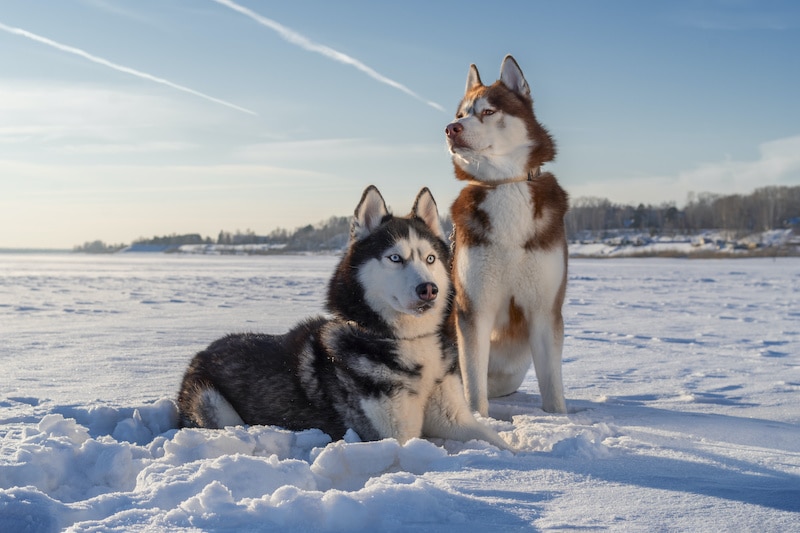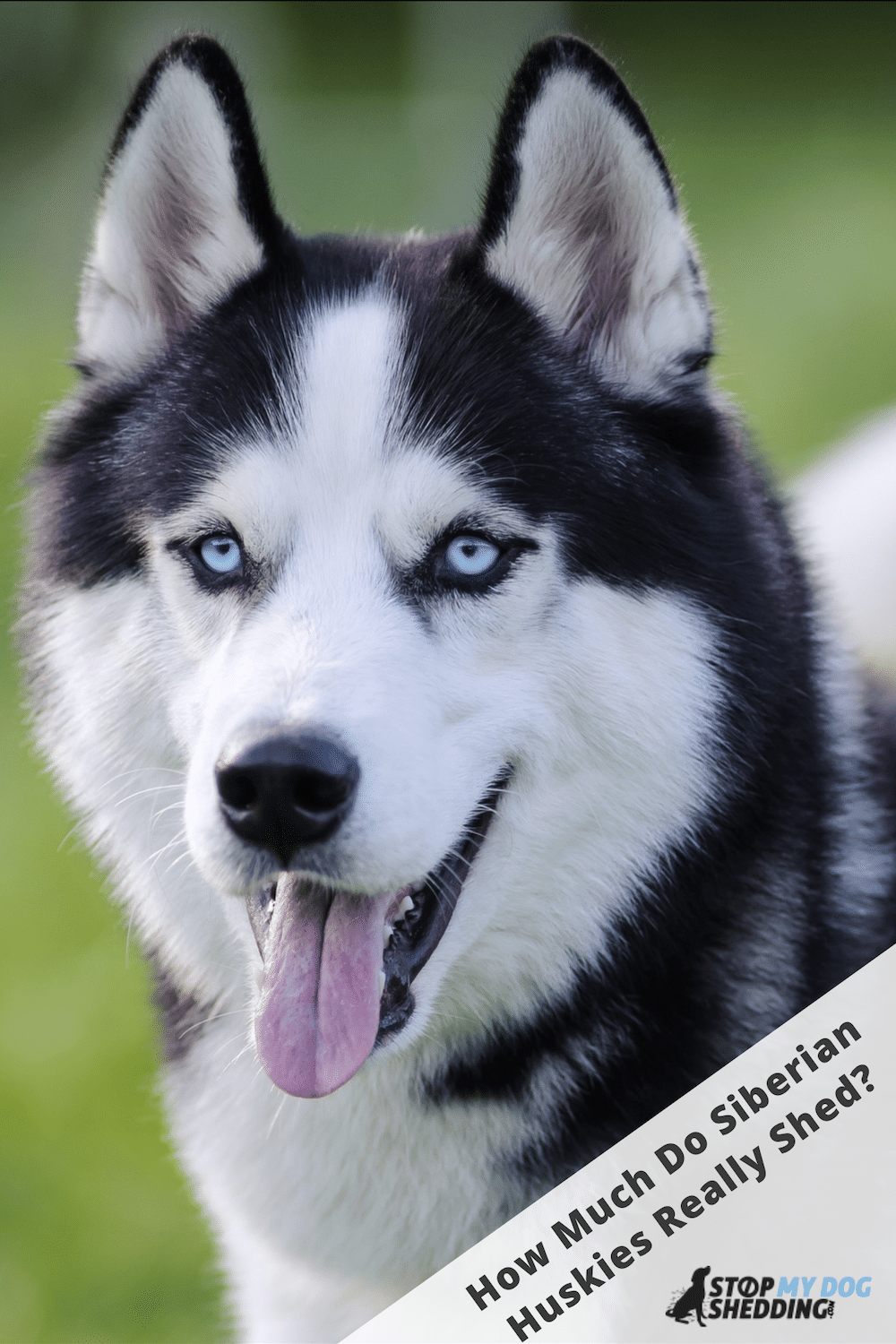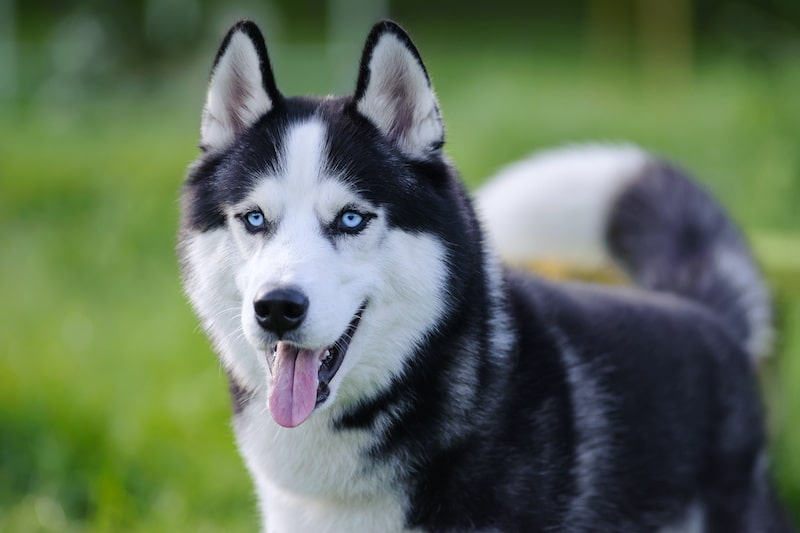Siberian Huskies are medium-sized sled dogs that originate from Northeast Asia, where they worked in packs to haul light loads over long, snow covered, distances. Huskies are loyal, energetic and friendly which makes them excellent working dogs as well as family companions.
And yes, they shed – a lot. Siberian Huskies are an above average shedding breed. They have a thick double coat that sheds moderately year round, and heavier during seasons like spring and fall. However, their coat is fairly easy to brush and this is one of the best ways to reduce the excessive shedding.
Let’s take a closer look at how much they molt and how you can reduce this, so you can enjoy having your Husky around, without spending too much time cleaning up his loose fur.
Recommended: Go here to see our top-rated dog hair blow dryers
Siberian Husky Shedding
Siberian Huskies are an above average shedding breed.
To help put this into perspective, they shed about the same amount of fur as an Akita and their cousin, the Alaskan Malamute.
However, they don’t shed quite as much as a German Shepherd, which they’re often compared with. Huskies tend to lose their fur more seasonally, rather than everyday as Shepherds do.
When do they shed most?
Huskies shed a moderate amount year round, but this intensifies once or twice per year due to seasonal shedding. What this means is that they typically shed more during seasons like spring and fall (autumn) as they naturally prepare for the change of season.
For example: Huskies shed their winter coat in spring because this is not need during the warmer months, and shed their summer coat in fall to make way for a thicker winter coat that will serve them better during the colder months.
This period of seasonal molting typically lasts for about 2-4 weeks at a time, and is commonly referred to as “blowing coat.”
How noticeable this sudden uptick in shedding is does depend on the individual dog though, as well as their local climate. Huskies living in warmer climates, for example, may shed more continuously year round than those in cooler climates.
Either way, seasonal shedding is normal. Most dogs do this. It’s just more noticeable with a dog like the Siberian Husky given how thick their coat is.
Why do they shed so much?
All dogs with hair shed to some extent, how much really depends on the individual breed and in particular what sort of coat they have. Basically, dogs with a shorter hair growth cycle and thick, double coats (like the Husky) shed more. And when they do shed, it is typically more noticeable than a dog with a short, single coat.
There are other factors that contribute to shedding though.
For example, what you feed her can make a difference to how healthy her coat is, which in turn can impact the level of shedding. Especially if her coat is dry or if she has developed an allergy to the food she’s eating.
In some cases, shedding may be the result of an underlying problem. Even heavy shedding can be considered “normal” in breeds like Huskies and Malamutes for example, but sometimes it may not be. So if you are concerned about your dog’s shedding, for whatever reason, contact your local veterinarian.
How to Stop a Siberian Husky from Shedding Excessively
There’s no way to completely “stop” your dog from shedding, but you can significantly reduce it and how much of it ends up floating around your home.
And it really comes down to brushing, bathing, and diet. If you can get these few simple things dialed in, you can win the battle of the fur. So let’s take a closer look at each method.
Brushing
Brushing your Siberian is probably the most effective method of reducing shedding. This may sound simple, and it is, but it works.
Not only does proper brushing help to remove the dead fur before it falls out (which can save you a lot of time vacuuming), but it is good for his coat as it spreads the coat oils. So brushing works to help prevent excessive shedding and how much of their loose fur ends up falling out.
How often should you brush?
From a general coat maintenance perspective, you really only need to brush your Husky once or twice per week. However, during times of heavy shedding, you may want to step it up to daily brushing to get this under control.
What sort of brush should you use?
The type of brush you use really depends on the individual breed. Huskies have a thick, medium length outer coat and a soft, dense undercoat. So, during normal periods of shedding, a pin brush or slicker brush and comb work well.
A pin brush is made up of widely spaced wire pins with rubber or plastic tips on the end. And a slicker brush is very similar, but with finer wire bristles.
The pin or slicker work well for the top coat to remove any mats, knots and debris caught up in his coat, as well as the bulk of dead fur. And the metal comb works well for undercoat and top coat alike.
However, during heavier periods of shedding, a good quality undercoat rake or deshedding tool may be worth using. Either of these are going to be more effective at reaching the fluffy undercoat, which sheds seasonally, than a regular brush or comb.
You can learn more about the different types of dog brushes here.
Bathing
Bathing is another effective tool in your shedding arsenal. Siberians definitely don’t need to be bathed often, but the occasional bath during heavy periods of shedding can really help.
And the reason is because, when you bathe him, you are removing the old hairs and loosening them up. Which can make it really effective to do before brushing. But there are some things you will want to keep in mind here, before you whip out the suds.
Firstly, always use a good quality dog shampoo (one that is designed for dogs) because using cheap or human shampoos can cause dryness in his coat, which in turn can increase shedding.
Second, try to avoid over bathing. You really only need to bath a Husky a few times per year, but with the right dog shampoo you can bathe more often as long as it isn’t drying out his skin and hair, which isn’t good for him or your crusade against excess shedding.
Third, when you do bathe your Siberian, make sure to allow his coat to dry before you start brushing. Because otherwise you run the risk of pulling at his hair which isn’t pleasant or good for him. This is why some choose to use a cool hand dryer before and during brushing as this ensures his coat is dry and can help remove a lot of the dead undercoat fur.
Diet
Feeding your Siberian Husky a good quality dog food can make a big difference to their quality of life and how much they shed. It’s not as if feeding your Husky an expensive dog food will eliminate shedding, it won’t.
But dog foods made of high quality ingredients, that contain healthy fatty acids like Omega 3 and Omega 6, can improve the condition of their skin and hair. Which in turn means they are less likely to molt due to dryness.
In addition to a good dog food, there are some great natural supplements and home remedies, like coconut oil for example, which won’t magically stop the shedding, but may help reduce it.
Related: Does Coconut Oil Help Reduce Shedding?
These aren’t the only ways to reduce excess shedding. But together, these few simple tips can make a big difference as to how much your Husky sheds and how much time you spend cleaning up the loose fur he drops.
Recommended: Go here to see our top-rated dog hair blow dryers
What Makes Siberian Huskies Unique?
Siberian Huskies are a medium breed of working dog that, according to the American Kennel Club, were bred by the Chukchi people many years ago as highly capable sled dogs.
They worked in packs to pull light loads over long distances in snowy conditions. Which is the same purpose that their larger cousin, the Alaskan Malamute, was bred for.
But they weren’t just bred to be sled dogs, Huskies also made excellent companions, and still do to this day. In fact, the loyal, friendly nature of the Husky has made him one of the more popular breeds in the United States.
There’s even a statue of a Husky named Balto in Central Park, New York. The story goes that, in 1925, Balto led a team of sled dogs 658 miles across Alaska to deliver a lifesaving serum to the people of Nome.
The Siberian’s strength, personality and thick coat served him well during these cold transport missions. And the fact that sled dogs have to work together may explain why Huskies are known to be good with other dogs, which is a plus if you’re considering adopting and already have dogs.

Another good thing about the Husky is that they’re fastidious. Like cats, they clean themselves often which means they typically don’t have that “doggy odor” that is common among many dogs.
With that being said, they are known to be a bit mischievous and independent at times, so they may not be very suitable for first time dog owners, or if you need to leave them alone a lot.
And as mentioned, they shed lots of fur. So not only are you going to notice hair floating around your home, but they are virtually the opposite to a hypoallergenic dog breed, like the Schnauzer, so aren’t ideal for those with allergies.
At the end of the day though, the Husky is a beautiful and unique breed. So if you’re not bothered about how much he sheds, and you don’t mind brushing him regularly, you’ll love having him as part of your family.
Related Questions
Why Do Huskies Shed So Much?
Shedding is normal for most healthy dogs with hair, but it can be particularly noticeable in dogs like the Siberian Husky because they have such thick, double coats that shed seasonally.
With that being said, sometimes factors like allergies, stress, dry skin, or poor diet for example, can cause shedding beyond what it considered normal. And if this is something you’re concerned about, it may be worth contacting your local veterinarian.
When Do Huskies Shed Most?
Huskies shed seasonally. Which means that once or twice per year (normally during spring and fall) they shed their coat more heavily, and this period of heavy shedding may last for as much as 2-4 weeks at a time.
Can You Shave Your Siberian Husky?
No, you should definitely not shave your Siberian Husky. Doing so might save you some work when it comes to grooming and cleaning up their loose fur, but it’s not a good idea. Huskies need their coat, especially their undercoat, to insulate them both hot and cold weather and protect them from things like sunburn.
Are Siberian Huskies Hypoallergenic?
No, Siberian Huskies are not hypoallergenic. No dog is truly hypoallergenic though, but since Huskies shed quite heavily and their coat produces lots of dander, they aren’t considered hypoallergenic. You can learn more about hypoallergenic breeds here.
How Often Should You Bathe Your Husky?
You only really need to bathe your Husky a few times per year. Huskies are fastidious and tend not to have that typical dog odor, so they don’t need regular baths. However, bathing a little more frequently (with a quality dog shampoo that doesn’t dry out his coat) can help when it comes to shedding.
What’s the Best Way to Reduce Shedding?
The best ways to reduce how much fur your Siberian sheds is through regular brushing, occasional bathing, and proper diet. Together, these can help you get the shedding under control. And if you want to learn about other ways to reduce shedding, check out this article.
Any Good Lower Shedding Breeds?
There’s no replacement for a Siberian Husky. And the truth is, other popular breeds like the Labrador, Golden Retriever and German Shepherd are all heavy shedders.
But if you are looking for a working dog (which the Siberian is) that sheds less, then the Chinook and Standard Schnauzer are moderate to low shedding dogs worth considering. Or virtually any kind of Pointer, but these are more hunters than working dogs.
If you don’t care about anything other than getting yourself a low shedding dog, that isn’t very difficult to groom, you may like a breed such as the Italian Greyhound, Basenji, or Whippet.













Please note: By submitting a comment using the above comment form, you confirm that you agree with the storage and handling of your data by this site as detailed in our Privacy Policy.